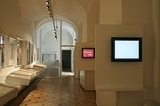
Department of Planned Languages and Esperanto Museum
Encyclopedia
The Esperanto Museum in Vienna
, Austria
was founded in 1927 by Hofrat Hugo Steiner and was incorporated into the Austrian National Library
as an independent collection in 1928. Today it is at the same time museum, library, documentation centre and archive. It accommodates the biggest collection of artificial languages in the world and a linguistic research library for language planning. Since 2005, the Department of Planned Languages and Esperanto Museum (German
: Sammlung für Plansprachen und Esperantomuseum; Esperanto
, Kolekto por Planlingvoj kaj Esperantomuzeo) has been located in the baroque Palais Mollard-Clary
.
The holdings of the collection consist of more than 35,000 library volumes, 2,500 periodical titles, 3,000 museum objects, 2,000 autographs and manuscripts, 23.000 photographs and photographic negatives, 1,100 posters and 40,000 pamphlets. In all, approximately 500 various planned languages are documented, of which the most important are Esperanto
and Interlingua
.
Vienna
Vienna is the capital and largest city of the Republic of Austria and one of the nine states of Austria. Vienna is Austria's primary city, with a population of about 1.723 million , and is by far the largest city in Austria, as well as its cultural, economic, and political centre...
, Austria
Austria
Austria , officially the Republic of Austria , is a landlocked country of roughly 8.4 million people in Central Europe. It is bordered by the Czech Republic and Germany to the north, Slovakia and Hungary to the east, Slovenia and Italy to the south, and Switzerland and Liechtenstein to the...
was founded in 1927 by Hofrat Hugo Steiner and was incorporated into the Austrian National Library
Austrian National Library
The Austrian National Library , is the largest library in Austria, with 7.4 million items in its collections. It is located in the Hofburg Palace in Vienna; since 2005 some of the collections are located in the baroque Palais Mollard-Clary...
as an independent collection in 1928. Today it is at the same time museum, library, documentation centre and archive. It accommodates the biggest collection of artificial languages in the world and a linguistic research library for language planning. Since 2005, the Department of Planned Languages and Esperanto Museum (German
German language
German is a West Germanic language, related to and classified alongside English and Dutch. With an estimated 90 – 98 million native speakers, German is one of the world's major languages and is the most widely-spoken first language in the European Union....
: Sammlung für Plansprachen und Esperantomuseum; Esperanto
Esperanto
is the most widely spoken constructed international auxiliary language. Its name derives from Doktoro Esperanto , the pseudonym under which L. L. Zamenhof published the first book detailing Esperanto, the Unua Libro, in 1887...
, Kolekto por Planlingvoj kaj Esperantomuzeo) has been located in the baroque Palais Mollard-Clary
Palais Mollard-Clary
Palais Mollard-Clary is a Baroque palace in Vienna, Austria. It is located in the first district Innere Stadt, at Herrengasse 9.It was built from 1686 to 1689 for Count Mollard . In 1760, it was bought by Count Franz Wenzel von Clary-Aldringen. Emperor Joseph II held his famous "round tables" here...
.
The holdings of the collection consist of more than 35,000 library volumes, 2,500 periodical titles, 3,000 museum objects, 2,000 autographs and manuscripts, 23.000 photographs and photographic negatives, 1,100 posters and 40,000 pamphlets. In all, approximately 500 various planned languages are documented, of which the most important are Esperanto
Esperanto
is the most widely spoken constructed international auxiliary language. Its name derives from Doktoro Esperanto , the pseudonym under which L. L. Zamenhof published the first book detailing Esperanto, the Unua Libro, in 1887...
and Interlingua
Interlingua
Interlingua is an international auxiliary language , developed between 1937 and 1951 by the International Auxiliary Language Association...
.

